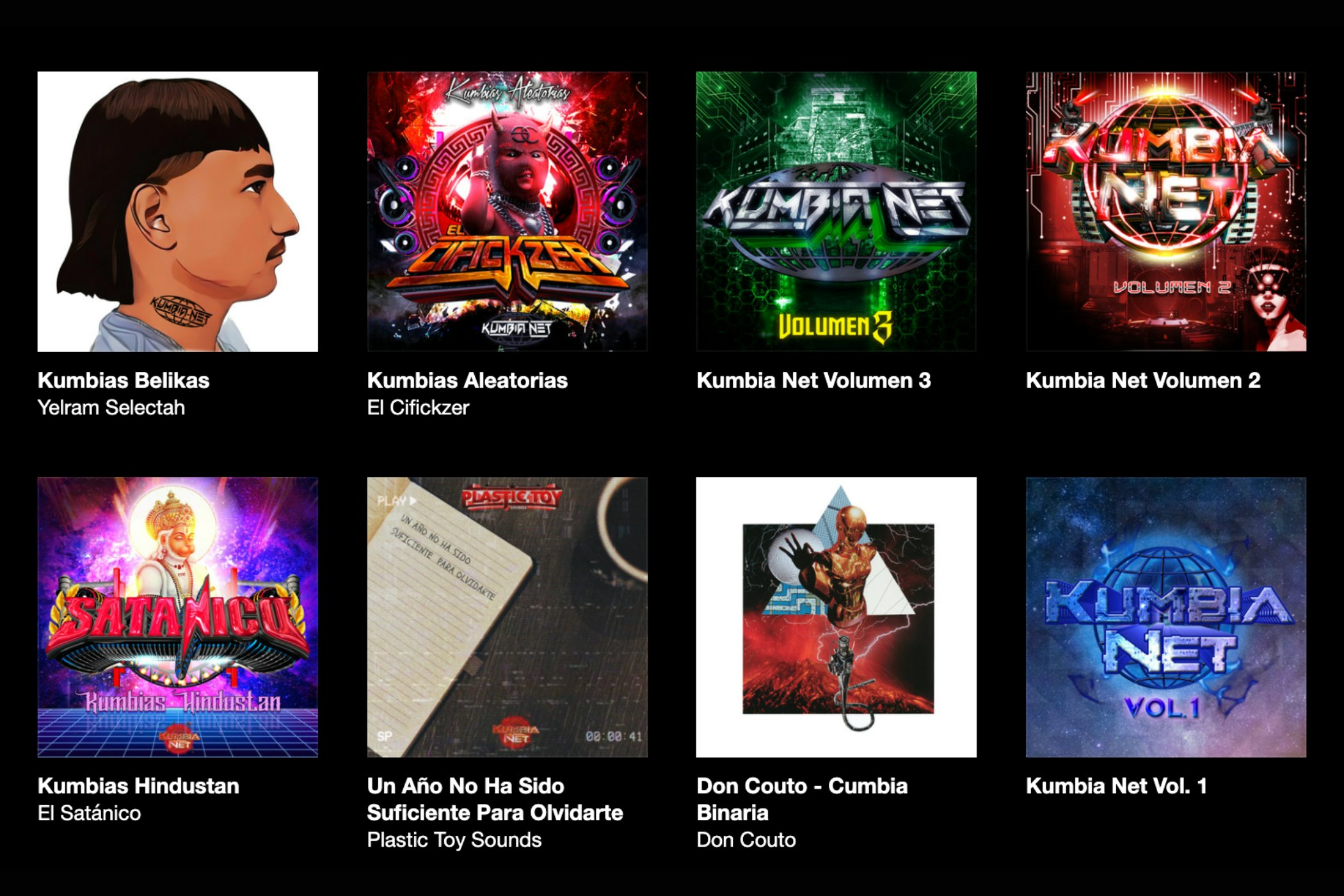Amid flashing lights, lasers, and smog machines, paired-up dancers emerge from a circle of spectators at Mi Sabor Café, a restaurant-turned-dancehall in the Brooklyn neighborhood of Bushwick. Beneath this intersection of the M and J subway lines, where botanica shops meet Dunkin’ Donuts and flower shops are used as fronts for sea-foam green cafés, the hypnotic beat of the guacharaca— a repeating chik-chika-chik-chika-chik rhythm, central to the tropical genre of cumbia— booms from heavy speakers.
Suspended on a small stage, Turbo Sonidero, a cumbia DJ and producer from California, and Bronx-native, hellotones, perform their duties as bicoastal musical bricoleurs, readily dialing up the bass for a well-outfitted crowd inside the club, donning cowboy-inspired outfits, Tecate Beer crop-tops, and Virgin of Guadalupe paraphernalia, and those outside catching a smoke break under the fluorescent lights of a taco truck.
Once the IRL moveable sound systems come undone on the dancefloors of Brooklyn, San Jose, California, and Mexico City, these cumbias live on as part of Kumbia Net, a digital, global repository of futuristic cumbias with roots in the US and Mexico.
Originally a genre developed in the Colombian Caribbean, cumbia and its many iterations have become the musical lingua franca of Latin America. But to Mexicans living across Mexico and the United States, cumbia has become a transnational movement that fuses together popular iconography to develop a singular visual identity, often wrapped up in the mythology of the two countries.
“Born out of the most remote corners of the Deep Web,” Kumbia Net is further transforming this blended cumbiero identity. It is a “Kumbiero Cyberspace, where “any dancer can hack the dance floor” to the tune of “the most hallucinatory synthesizers, the most infernal congas, and the raspiest güiros.”
Founded by Turbo Sonidero and producer Arrabalero from the UK, Kumbia Net is a real community built with digital-native sensibilities. With its crew of over seven producers making cumbias in The Bay Area and Southern California in the US, and Monterrey, San Luis Potosí, Mérida, and Mexico City in Mexico, Kumbia Net delivers the heaviest and darkest cumbias from a place called Cyber Aztlán.
But prior to Aztlán becoming Cyber, it was simply Aztlán, a promised land for the Mexica people. It was believed to be the location where the imperial capital of Tenochtitlán was established in the 14th century, which encompasses modern-day Mexico City. The city was destroyed by Hernán Cortés and his army two hundred years after its founding, but the myth and search for Aztlán persisted for centuries.
Prior to Aztlán becoming Cyber, it was simply Aztlán, a promised land for the Mexica people.
Spanish colonizers, bewitched by medieval tales of lands of riches, believed Aztlán was actually located in the American Southwest. This territory was briefly part of Mexico, before it was seceded to the United States during the Mexican American war, creating “the other Mexico,” as the norteño group Los Tigres del Norte have referred to it in song (The other Mexico that /
here we have built / On this ground that has been / National territory).
Chicano scholar Gloria Anzaldúa returns to this place in her Latinx studies opus, Borderlands La Frontera: The New Mestiza in the 1980s. In Anzaldúa’s American Southwest, Aztlán is rendered as an imagined, borderless place that weaves together Mexican and Chicano subjectivity, eschewing the geopolitical boundaries and economic asymmetry that keeps these real communities apart.
Now, Kumbia Net is taking Aztlán online, drawing from the sounds and images from Mexican barrios in Mexico and the US, to create a different borderless space that mingles with the real and the imagined, across space and time.
As critic Josh Kun once wrote, cumbia DJs, producers, and MCs known as sonideros or soundmen, became “the architects of a mobile, binational sonic community,” whose “undocumented music full of clandestine codes” has traveled the world seamlessly by way of vinyl, cassettes, and digital platforms, such as Soundcloud.
The fantastical nature of cumbia comes from the DJ’s ability to construct what Kun calls, “the aesthetics of allá” — a way of using sound technology to recreate the “sonic, cultural, and political geographies of Mexico” and the imagined Mexico, enacted by those living on the other side of the northern border.
To Kun, “Allá,” is a word in Spanish that denotes a place that is "beyond" or not yet visible, which is distinct from the “aquí,” or the visible “here.” While the cumbia party, known as el baile, enacts the here and now—whether it takes place on a field in the Mexican state of Puebla, Milwaukee’s Buddhist Temple Hall, or a club in Warsaw, Poland —the style each DJ injects into the music and the cultural codes it nods to, conjures the allá.
The prototype for Kumbia Net sound can be heard in Turbo and Arrabalero’s Grupo Jejeje album, a twelve-track cumbia editada hallucination that takes you through cumbia samples looped with electronica, as well as nods to Afrofuturism, hip-hop, and house music.
Its cover art, designed by the iconic Jaime Ruelas, depicts a crowded metropolis lined with modern buildings and Egyptian pyramids. A Mexica pyramid hovers over the depicted town square like a spaceship.
This imagery is not far removed from how the role playing game Shadowrunner imagined Aztlán in 1995—a powerful state spanning the American Southwest, Mexico, and Central America, inhabited by humans, ghouls, and feathered pre-Hispanic deities.
Cyber Aztlán is Kumbia Net’s own allá—a sonic territory in the elusive, borderless space of the internet. Like many web projects that create offline communities and delineate scenes, Kumbia Net is different in its preservationist instinct, innovating a centuries-old genre while consistently paying homage to its real and spiritual past. “Nobody knows where it's from or where it's at. It's just a concept, you know, and it's an idea,” Turbo said.
A documentary about Kumbia Net is currently in the works, written, shot, and produced by LA-based filmmaker Alvaro Parra, known as Space Primo. Per Parra, Space Primo is an alien who came to earth and fell in love with cumbia. The allá is in the name.
Want the full Nightlife Review series by Dirt & Elsewhere?
It's free, and by signing up below you'll get all digital dispatches, free entry to the launch party, and first access to the printed zine.



